Special Collections and Archives
Preserving the Legacies of Great American Artists
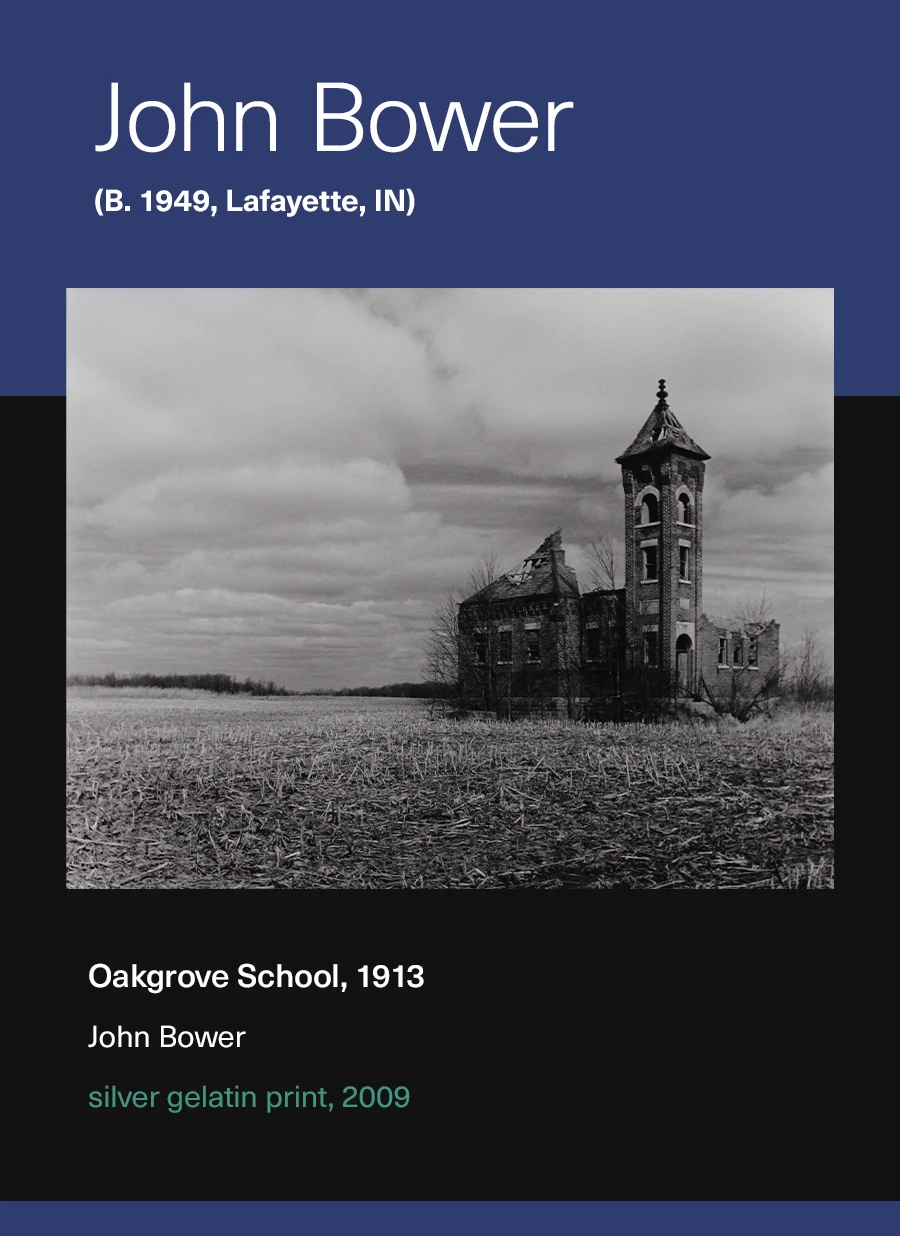
Recent additions to FWMoA’s Special Collections and Archives Initiative include the photographic work of Indiana artists John and Lynn Bower, who were named Distinguished Hoosiers by Governor Daniels in 2011.
John Bower is an Indiana photographer who travels the back roads of the state to capture the relics and ruins of Hoosier heritage. His haunting black and white photography honors the many phases of a bygone era. Bower has published seven photographic books through his and his wife’s publishing company, Studio Indiana, that reflect the many aspects of the state’s history: architecture, transportation, cemeteries, agriculture and farming, and Indiana industry. Bower holds a B.S. in Industrial Education from Purdue University and a M.A. in Education from Ball State University.
Lynn Bower was born in Detroit, Michigan, and grew up in Grosse Pointe Woods. She earned degrees in drawing, design, and art education from West Michigan University before moving to Kendallville, IN, where she met her husband teaching at Kendallville Middle School in 1972. Lynn works in a variety of mediums, including traditional pencil and ink drawings as well as digital painting, metal sculpture, jewelry, and fiber arts. She hopes her humorous art will gently nudge people awake from the predictable, returning us to the wonder we experienced as children.
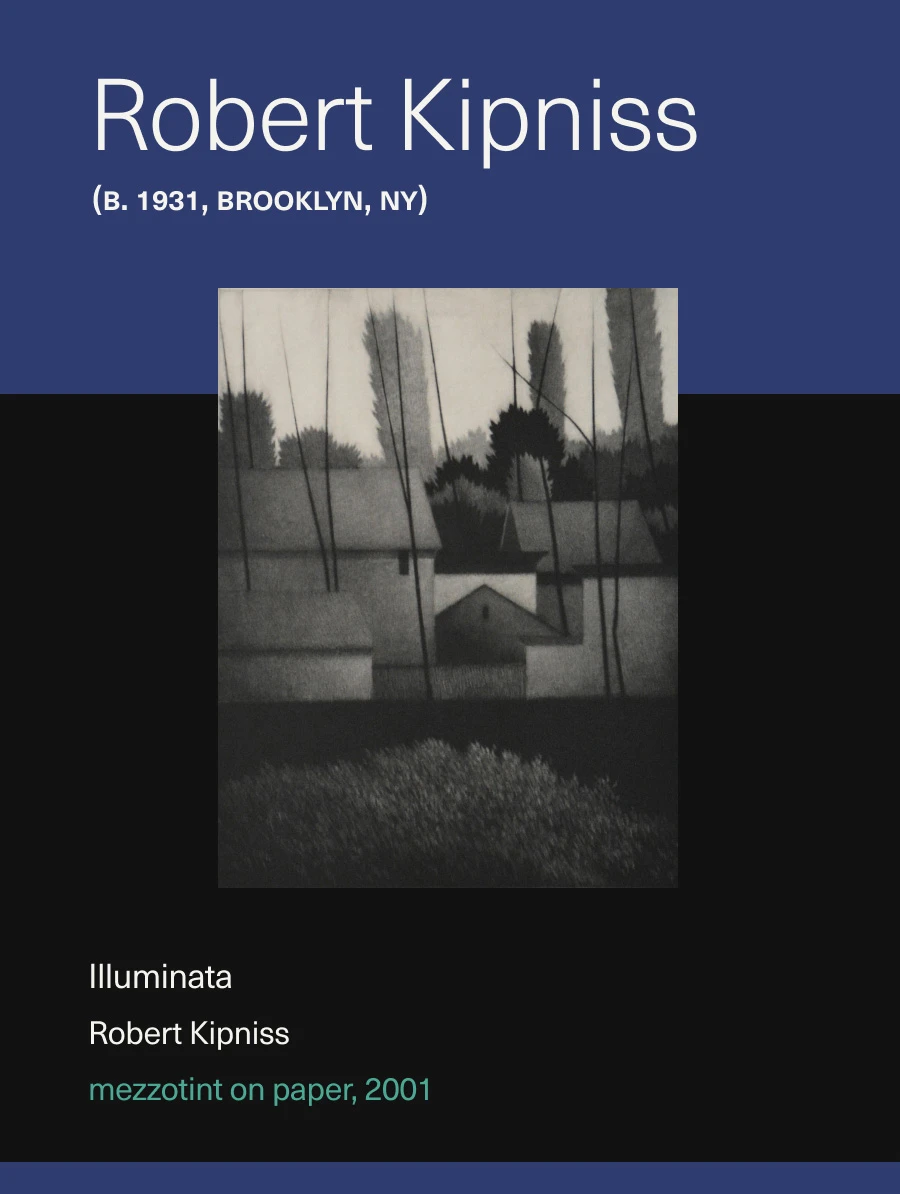
Painter, printmaker, and writer Robert Kipniss’ first art class was at the Art Students League in 1947. He eventually earned a Master of Fine Arts from the University of Iowa, and in the early 1950s he was awarded his first one-man show in New York City.
In 1963, he sold forty paintings, and more success followed. In 1967, Kipniss tried drypoint and lithography, and they were represented by Associated American Artists. Kipniss began making mezzotints in the late 1980s, and by 1990 the majority of his prints were mezzotints. His subjects often include austere limbs of trees; spare, modest houses with simple shapes; and shadowy interior scenes. Although his scenes hint at the presence of human life, the absence of figures speaks to his interest in the poetry of our surroundings and the grace inherent to the unspoken atmosphere.
Since 1951, Kipniss’ work has been included in solo exhibitions at the Tyler Museum of Art in Tyler, TX; The Mississippi Museum of Art; Springfield Museum of Art in Springfield, OH; and the Fort Wayne Museum of Art. Group exhibitions include those at the Metropolitan Museum of Art; the Figge Art Museum in Davenport, IA; and the New Britain Museum of American Art in New Britain, CT. He has received lifetime achievement awards from The Artists’ Fellowship and the Society of American Graphic Artists, both in New York City. Selected public collections include the Detroit Institute of Arts, the Metropolitan Museum of Art, and the Whitney Museum of American Art. Kipniss’ gift to FWMoA, in 2016, includes 110 mezzotints and lithographs.
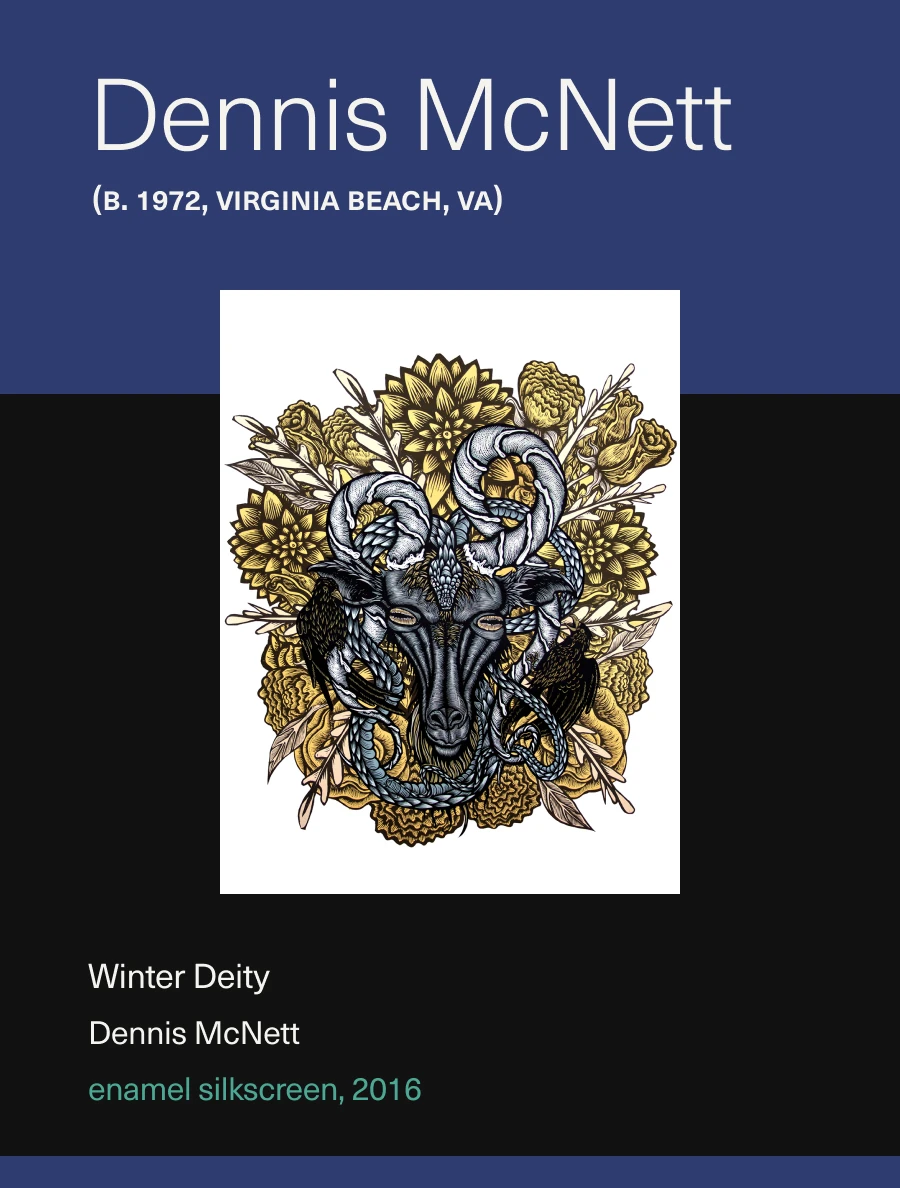
Philadelphia-based artist Dennis McNett considers himself a storyteller at heart whose inventive and imaginative personal mythology about the world directly translates into the lively works he creates. Drawing from varied sources, including traditional folklore as well as popular culture stories, he continues to innovate while still honoring age-old traditions.
McNett earned a Master of Fine Arts from Pratt Institute and a Bachelor of Fine Arts from Old Dominion University in Virginia. McNett has over 20 years of experience specializing in wood carving and woodblock/relief printmaking. While wood engraving itself has its roots in 2D applications, McNett transcends those limitations by using carved markings as the basis for relief prints that become collage materials. They are then used to bring to life grandiose, three-dimensional installations at museums, art centers, galleries, city streets and other diverse environments.
Having shown internationally in places like The Victoria and Albert Museum in London and notable domestic spaces like the Jonathan LeVine Gallery and Joshua Liner Gallery in New York City, McNett has also contributed as a visiting artist and lecturer at universities throughout the country. He has been heralded in the past by The New York Times, Houston Chronicle, NPR, and Juxtapoz Art & Culture Magazine. In 2014–15, McNett completed a residency supported by the National Endowment for the Arts at the John Michael Kohler Art Center, and in 2009 was awarded a grant by the New York Foundation for the Arts. McNett’s 2016 gift to FWMoA includes 88 linocuts, woodcut and silkscreen prints.

Oxman came to the United States at the age of nine and studied printmaking and painting at the Pennsylvania Academy of Fine Art, Philadelphia, Pennsylvania from 1962–65. She studied at the Academy of Munich, Germany in 1966, where she continued to execute large-scale woodcuts. Oxman has served as Visiting Critic at the Pennsylvania Academy of fine Art; Director of the Ben Shahn Graphic Workshop at the Skowhegan School of Painting & Sculpture, Skowhegan, Maine; and Artist-in-Residence, Bryn Mawr College, Bryn Mawr, Pennsylvania.
Oxman creates richly textured color etchings in her precise style. Her multi-plate aquatint etchings present complex still lifes of richly patterned Oriental rugs upon which rest an overwhelming array of shadow-less objects. The artist selects from a collection of items that includes opened letters and envelopes; picture postcards from museums; birds, feathers and nests; potted plants; oriental boxes; ripe fruits and vegetables. The objects in Oxman’s still lifes appear to levitate as a result of the artist’s tilted, nearly bird’s eye, perspective. The viewpoint alludes to Japanese woodblock prints. A sense of stability and calm emanates from her minutely detailed printed surfaces and their warm, earthy, subtle range of tones.
In 1967 Oxman was awarded a prestigious Certificate in Printmaking from the Royal College of Art, London, England, where she specialized in etching. The artist has been honored with dozens of grants and awards, including three prizes from 1996–2000 from the National Academy of Design in New York.
Oxman’s etchings are in permanent United States collections at the National Museum of Women in the Arts; the Pennsylvania Academy of Fine Art; the National Academy of Design; the Philadelphia Museum; the New Jersey State Museum; the Smithsonian Institution; the U.S. Department of State; the University of Delaware; the University of Maryland; the American University. Oxman’s gift to FWMoA in 2016 includes 95 etchings and aquatints, plus assorted printing plates and ephemera.
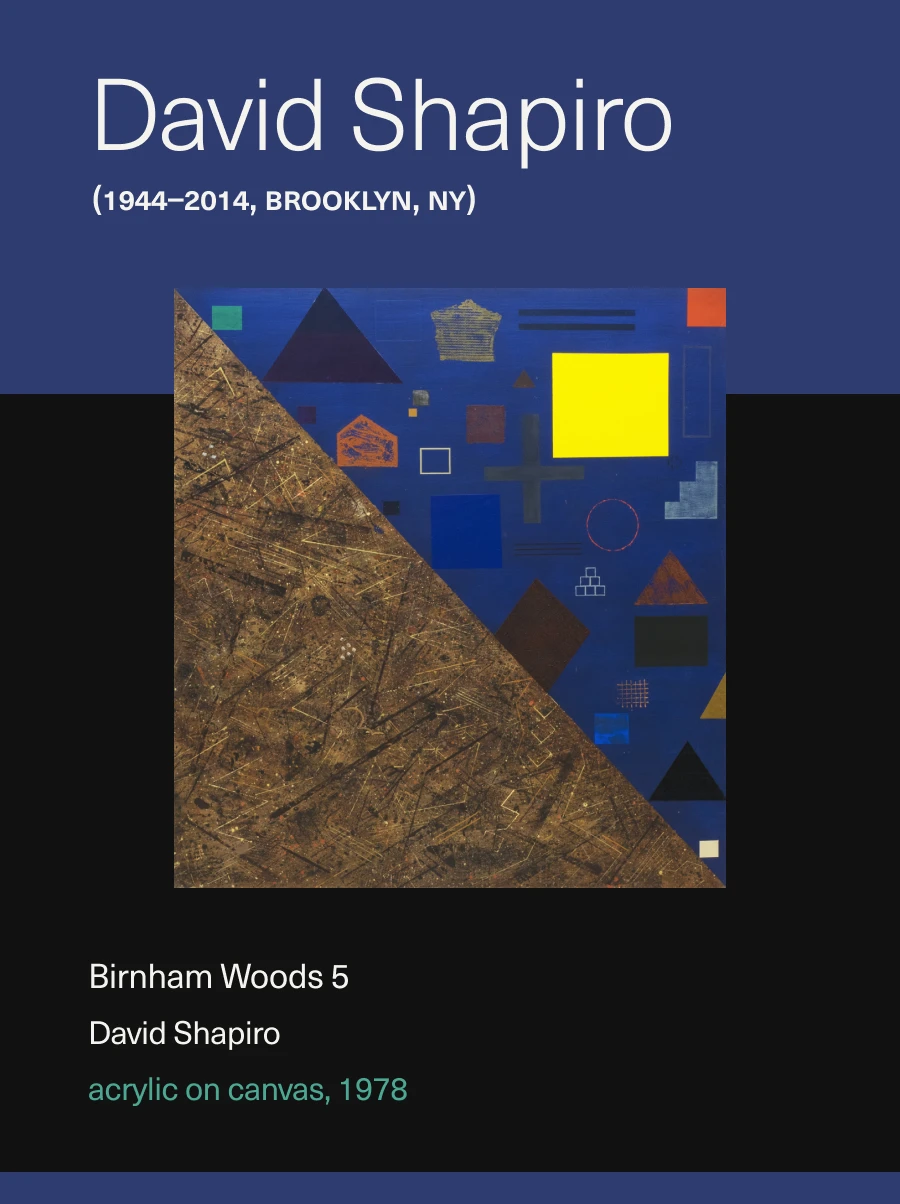
Shapiro earned a BFA from the Pratt Institute in Brooklyn, followed by an MFA from Indiana University. His work is included in many public and private collections including The Museum of Modern Art, the Solomon R. Guggenheim Museum; the San Francisco Museum of Modern Art and the Cleveland Museum of Art.
Shapiro’s work often features adjacent square or rectangular panels united by a color scheme or spectrum that is broken with changes in patterning. The titles of his works invoke meditative practices of Eastern traditions, such as “Clearing” the mind, the “Savasana” yogic posture, “Mudra” (a symbolically significant Buddhist or Hindu hand gesture), or the concept of the “Origin and Return”— the starting and ending of meditation and even life in one state of consciousness. His works from the 1970s evoke a balancing of geometric shapes and expressive calligraphic backgrounds. In the 1980s, Shapiro began working in multi-panel compositions that reference Japanese screens. Over the course of his career, Shapiro created over fifty editions and worked with IFPDA members Tandem Press, Wildwood Press, and Goya-Girl Press. Shapiro’s 2016 gift of nearly 800 prints and paintings is the largest in scope and value in the history of the Fort Wayne Museum of Art.
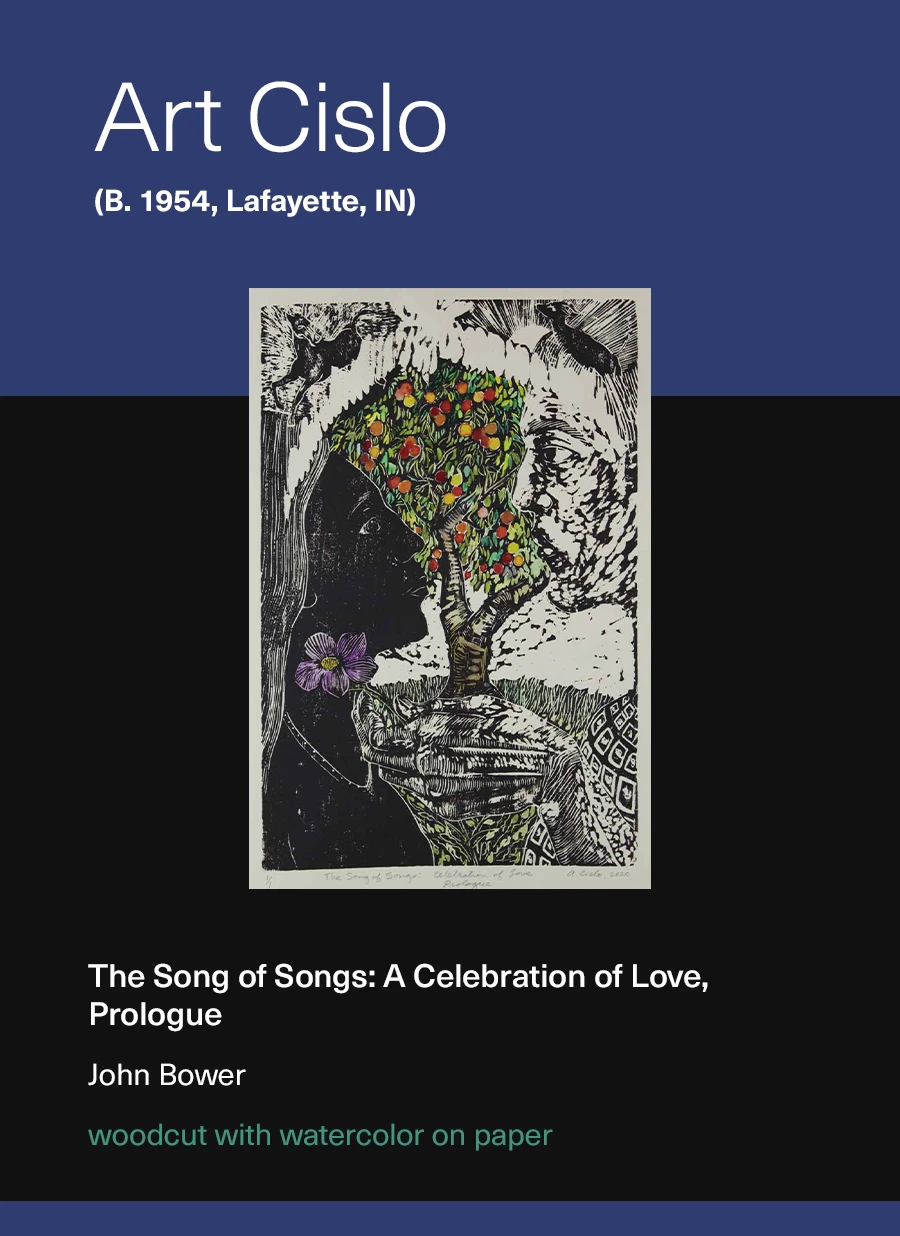
Art Cislo was born in Detroit in 1945 and earned a Bachelor of Fine Arts from Wayne State University in 1967. He moved to Fort Wayne in 1971 to work at International Harvester as a clay modeler, a career similar to his father’s, who was a modeler of hood ornaments in the automotive industry.
Growing up, Cislo was surrounded by books in his Polish-Catholic home and enjoyed long talks with his family, especially his father, about the theology of his faith as well as the stories of the Bible. The theological discussions spurred his intellect for sure, but it was the stories of his faith that captured his imagination most. To this day, the stories of the Bible unleash his creativity and are the means through which he can most deeply express himself. He chooses these subjects not for the edification for others, but because he finds sacred scripture to be an inexhaustible reservoir that help explain the mysteries of man’s natural and spiritual existence.
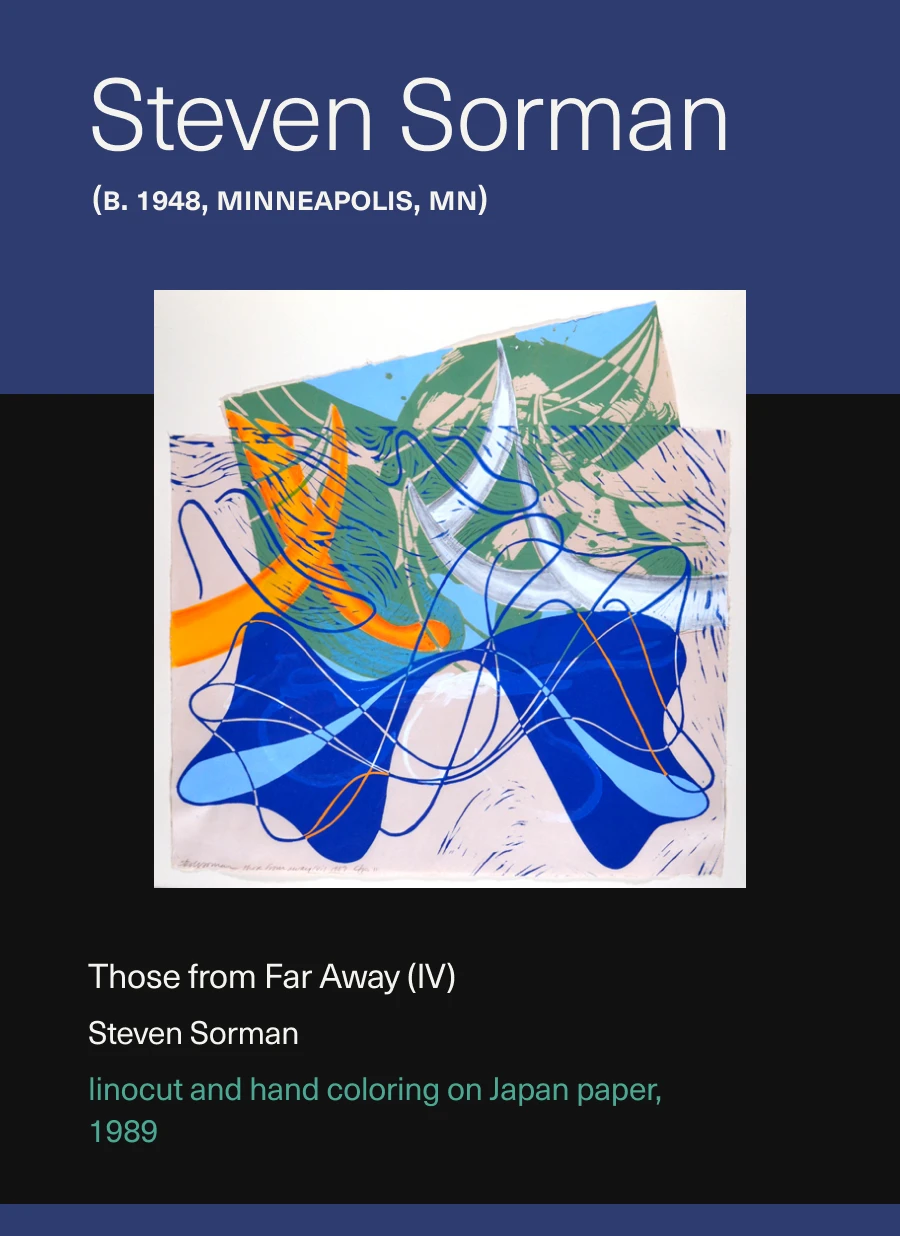
Sorman’s gift to the Museum in 2014 includes 230 prints and paintings, with promised gifts of one print from each edition he creates in perpetuity.
Sorman earned a Bachelor of Fine Arts from the University of Minnesota in 1971. Sorman is noted for abstract prints and paintings that are visually complex and full of detail and vivid color. Art critic and curator Mason Riddle noted the subtle evolution and reinvention of Sorman as she wrote, “Where some artists make a career out of bold stylistic shifts, Sorman excels in a consistency of artistic practice. With the eye of a connoisseur, he discriminately borrows formal elements from the aesthetic trove of his past to create a more visually compelling present.”
Since 1970, over 80 one-artist exhibitions have featured Sorman’s work. In the 1970s, prestigious exhibits included the Paper as Medium, Smithsonian Institute; The National Print Exhibition at the Brooklyn Museum and the 13th International Biennial of Graphic Art in Ljubljana, Yugoslavia. In the 1980s, Sorman was invited to exhibit at the Bienal Americana de Artes Graficas at the Museo de Arte La Tertulia in Colombia.
Although the FWMoA has collected artwork by Sorman since 1985, it wasn’t until nearly 20 years later when our Sorman collection began to blossom, thanks to gifts from local collectors and strategic purchases. Sorman’s work has been a favorite of FWMoA CEO and Chief Curator Charles Shepard since he encountered it as a graduate student at Williams College while helping organize the now-famous 1984 exhibit, “The Modern Art of the Print” at the Museum of Fine Arts Boston.

Chuck Sperry is an internationally renowned printmaker, poster designer, and owner of Hanger 18 Print Studio, located in Oakland, CA. He has created hundreds of limited-edition posters for legendary bands such as The Beatles, The Rolling Stones, Dave Matthews Band, Madonna, Pearl Jam, The Black Keys, and The Avett Brothers.
Originally from Dayton, OH, Sperry has dominated the poster scene for over a decade and is recognized for his extensive use of psychedelic color in his silkscreens. While he likes to play on the classic Greco-Roman idea of the “muse” as the main inspiration for art and music, Sperry’s work is also reminiscent of vintage ‘60s and ‘70s rock albums, with stylistic designs pulled from Art Nouveau, the Vienna Secession, and the Belle Époque. The figures in his work are often emblematic of the energy of the creative spirit, expressing the synergy of social concern and popular iconography. This energy infuses his printing process, in which he utilizes up to nine color layers in his complex designs, resulting in a dazzling display of figures enveloped in expressive, hypnotic patterns.
In 2022, the Fort Wayne Museum of Art presented Color X Color: Selections from the Chuck Sperry Archive, which featured more than 150 of Sperry’s rock posters from our collection.
Altogether, more than 1,300 works of art have been donated by this group of artists in the last four years.

 The Special Collections and Archives Initiative is an innovative program that attracts, builds and cares for major in-depth collections of accomplished, but perhaps under-appreciated, artists of the late-20th and early-21st centuries. The first five artists invited to participate in this special collection have long-standing relationships with our curators. Those artists include John and Lynn Bower, Art Cislo, Robert Kipniss, Dennis McNett, Katja Oxman, David Shapiro, Steven Sorman and Chuck Sperry, who are masters of their craft and have made lasting contributions to the evolution of contemporary American art. By accepting large quantities of work by individual artists, we preserve the legacies of important American artists by caring for their bodies of work.
The Special Collections and Archives Initiative is an innovative program that attracts, builds and cares for major in-depth collections of accomplished, but perhaps under-appreciated, artists of the late-20th and early-21st centuries. The first five artists invited to participate in this special collection have long-standing relationships with our curators. Those artists include John and Lynn Bower, Art Cislo, Robert Kipniss, Dennis McNett, Katja Oxman, David Shapiro, Steven Sorman and Chuck Sperry, who are masters of their craft and have made lasting contributions to the evolution of contemporary American art. By accepting large quantities of work by individual artists, we preserve the legacies of important American artists by caring for their bodies of work.